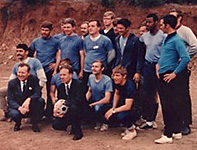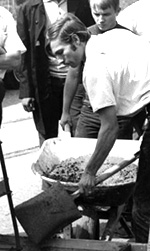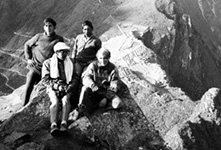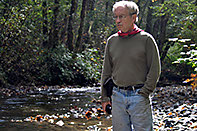“Discovering the Peace Corps . . . and Myself” by Dennis Kuklok (Bolivia)
Discovering the Peace Corps … and Myself
by Dennis Lloyd Kuklok (Bolivia 1968-70)
•
It was October, 1967. I had just dropped out of the University of Minnesota, where I was beginning my third year in the School of Architecture. I knew that I would now be drafted, since I would lose my student deferment. So, I volunteered. I wanted to get my military service over as quickly as possible. Then I would be free to do whatever I wanted. At that time, if you volunteered for the draft, you could complete your two years in the army in just 18 months.
My university education had made me see how immature, how unworldly I was. It had become painfully apparent how little I really knew about the world in which I was expected to design places for people. I had grown up in a large Catholic midwestern farm family, gone to Catholic grade and high school, and the furthest I had traveled was to Colorado to ski a couple of times. I had never seen the ocean, never eaten an avocado, had very limited understanding of the war we were in, or the Civil Rights movement which was in the news everyday. I didn’t know much of anything beyond my little white-bread midwestern world. I realized I could not begin to be a designer of places for others until I better understood both myself, and the world beyond my Catholic midwestern tribe. To grow up, to be able to explore the world freely, I needed to get the threat of the draft behind me. 18 months didn’t seem that long.
After volunteering to join the army, I went back to campus to get my tuition refund, and complete the paperwork associated with dropping out. I still recall what a beautiful, sunny autumn day it was. The campus trees were intensely colorful, the air tasted cold. I was not exactly happy, but I was relieved in that I no longer had to pretend that I was an architect amongst seemingly more experienced, more knowledgeable peers.
Walking down the long tree-lined mall that extended between the Student Union and Northrup Auditorium, I noticed a sheet of paper tacked to a tree. Nothing new, these kinds of flyers were ubiquitous on campus. I had learned to not see them, as they usually were about things I had no interest in. So, I walked by. But this day was different. Something made me stop, turn around, walk back and see what the flyer had to say. It’s words changed my life.
“Peace Corps representatives at Student Union this week”
I was nineteen years old. I didn’t have a college degree, only two of a five year Architecture program completed. I had never traveled. I knew little of the world. I had heard of the Peace Corps, but the Agency was only seven years old, and more of an idea than anything real to my world. Certainly it didn’t apply to me.
Still, something made me walk directly to the Student Union and at least listen to what these Peace Corps people had to say. After all, I was beginning my worldly life, and it had to start somewhere. What did I have to lose, no longer a student, I had time to check out things like this. It might come in handy later, when I was older.
To my surprise, the Peace Corps recruiters didn’t laugh at me, at my age, my inexperience, my lack of anything tangible to do or give. I was just a lost kid, about to enter the army and mature under its rigid guidance. They gave me some kind of language aptitude test. I scored high. This and the fact that I had 4 years of Spanish in high school, plus a little more than a passing sense of building (farm experience, architecture training) was, apparently, enough for them to think I might be a candidate.
In an hour I was transformed from being a for-certain boot camp private into a possible Peace Corps volunteer. All of a sudden, I saw a part of myself that was there, but had never acknowledged. A soldier was not my only option. I wasn’t a pacifist, but neither was I a supporter of the war in Viet Nam nor the military way of thinking. I knew about the latter, because not only did I have four years of Spanish, but I had four years of military, since I had attended an all boys Catholic military (ROTC) academy. I went in without stripes and graduated with barely one. I mainly did it because my two older brothers had gone there, and it was expected that I would do the same. Tradition is a powerful current in one’s life, hard to swim against.
Upon hearing that I had just volunteered to join the army, the PC recruiters reassured me that even this decision was not set in stone. They knew the rules. They advised me to go to my draft board office, rescind my volunteer action (they said I had 30 days to do this), and then move someplace else. Moving meant that my draft board would have to send (through the mail) my records to the draft board where I would take up residence, a process which usually took two months. They could not guarantee that I would be accepted to train, nor that I would not get drafted before this were to happen. But they were encouraging enough that I followed their advice. All of a sudden my life changed, from one where my path had been clear, but not one I really wanted, to one of unknown possibilities, adventure, the option of serving in a different way.
Born to serve
I had been raised to serve. In large Polish Catholic families, one or two kids were always “groomed” to become a priest or nun.
Both my Grandmothers had seen something of a possible vocation in me at a very young age. I was the one who led the prayers, I was the one who had a little altar and vestments made so I could play at being a priest. I was the one who was sent to visit seminaries where priests were trained. I was the one who received the monthly Maryknoll magazine, a a kind of Catholic National Geographic, highlighting the work of priests and nuns around the world. It had lots of pictures and uplifting stories of serving the “needy” in all corners of the world. By the time I was old enough for high school, I knew I was not interested in becoming a priest, but the idea of service, the interest in exotic places remained, though hidden under all the demands of school and work and family.
Becoming a Peace Corps volunteer would certainly make my two grandmothers happy. Wasn’t it a bit like being a missionary?
So, on that fateful October day, I called up a friend to tell him that I had just dropped out of school. To my surprise, he had done the same a week earlier. I told him I needed to move someplace while my PC application was processed. It didn’t take long for us to decide to drive to Vail, Colorado to ski the winter. We both loved to ski, winter was upon us, and what better way to spend it than ski everyday. So by the end of the month I had a job, bunkhouse bed, and season lift pass at Vail. And, my Eagle Colorado draft board was awaiting my papers, which arrived mid-December. Thankfully, the holiday season stopped any action being taken on them, but that would change in January.
Two letters
In January, I received two letters. One advised me that I would need to go to Denver for a pre-draft physical in March. The other invited me to become a Peace Corps trainee in a construction program in Bolivia.
Training would start in mid March, in Escondido, California. I immediately advised my draft board that I was moving to California in March, giving them the address of the training facility in Escondido. My new draft board office would be LA.
Being a trainee in Southern California did not give me a deferment from military service. I was still prime draft material according to the Selective Service. So, in April I had to take a day off Peace Corps training to travel to LA for a pre-induction physical.
Peace Corps Training

Escondido: PC Director Jack Vaughn visited, seen here holding a soccer ball. Dennis is front row, far right.
Luckily for me, my PC training had two components: first we had six weeks of intensive Spanish-language training in Escondido;

Detroit: Trainee’s Dennis Kuklok and Eric Lind mix concrete
following that there was six weeks in Detroit for “technical” training organized by the UAW where those in the building trades worked to improve the mostly rudimentary skills of the college educated trainees.
In April I advised my LA draft office of my new Detroit address, hoping that it would buy me enough time to complete training.
The strategy worked. In early July, I was sworn in as an official Peace Corps Volunteer. I was twenty years old. I advised my Michigan draft board of this fact, giving my new address as Peace Corps Office, La Paz, Bolivia. I no longer had to concern myself with how long it took mail to go from Michigan to Bolivia, since I received a deferment because I was now an official PCV.
For me, at that point in my life, the Peace Corps was a perfect fit. The three months of my training introduced me to a world of fascinating people, places and possibilities. And this maturing, this curiosity of the world, this love of differences, has continued to this day, and I hope that it to continues for as long as I live. The Peace Corps is not just a part of the State Department, a component of US international policy, a service organization. It is something that you join, not just for two years, but forever.

Dennis and friends perched atop Huayna Picchu, the mountain that towers over Machu Picchu.
At the end of my service, I convinced my three Bolivian counterpart CENPRITEC instructors to travel with me to Peru. None of them had been outside Bolivia before. We made our way by train, boat, bus, and truck to Cuzco and the ancient Incan city of Machu Picchu, sleeping under the stars in the ruins.
•
 Kuklok currently lives in Washington state in a yurt on 40 acres of temperate rain-forest with two anadromous (salmon bearing) rivers, adjacent to Olympic National Park. There he is developing salmon-themed educational materials (see his website AllSalmonConsidered.com), is building a house using alternative building materials and technologies (locally milled timber, straw bale, cob/earth), and maintains a large organic garden and orchard. His cartoons regularly appear in Funny Times. He also is writing and illustrating a series of children’s books, and continues creating bronze sculptures.
Kuklok currently lives in Washington state in a yurt on 40 acres of temperate rain-forest with two anadromous (salmon bearing) rivers, adjacent to Olympic National Park. There he is developing salmon-themed educational materials (see his website AllSalmonConsidered.com), is building a house using alternative building materials and technologies (locally milled timber, straw bale, cob/earth), and maintains a large organic garden and orchard. His cartoons regularly appear in Funny Times. He also is writing and illustrating a series of children’s books, and continues creating bronze sculptures.
Dennis, Please, a great beginning, but what did you do in Bolivia!
Dennis, I’m tracking with much of your story–similar to mine although I was in Guatemala. You might have enough stories to write a book! Mine is “Different Latitudes”–took a year but it was worth the effort.
There should be a special Registry for those PCVs who climbed Huayna Picchu and another Registry for those who climbed to the top of Huayna Picchu and slept overnight…1965 and 1973 respectively.
WM Evensen
Peru 1964-66
Although I never climbed Huayna Piccu, I did the Inca Trek over four days in my sixties with my husband.
IHi! I live in Escondido. Been my home 40+ years. My daughter served in PC Nepal and PC Ecuador.
Love the Escondido/ avocado story.
Meg
Dennis, great to reread some of your thoughts. As a Catholic farm Minnesota kid; when I was 10 years old I already had six siblings, and would eventually have 4 more. I have similar earlier thoughs of rarely been anywhere before my first airplane ride: Ocober 1966 Rochester MN to Syracuse NY for PC training, Tanzania XIII. Julius Nyere cancelled much of that program. I and others ended up in Sierra Leone1967-68. Patrick O’Leary
I too enjoyed this piece and hope to see it expanded. Great work!
Dennis, if you are the person who wrote a great piece about the Van Buren Bridge in Corvallis for the Thymes back in 1992, we need to get in touch. The bridge is threatened, and we think adapting what you wrote could help a bit.
My name is Rebecca Landis, and my email is landisr@peak.org.
Loved finding this Dennis! Carole Crews is visiting Seattle and I invited her out to meet you if possible ! She wrote the Cob house building book!
WHEN ELDERS DIE
To measure we need to know not only the influence of the observer, but of the observing system.–Fritjof Capra, The Tao of Physics 1975 Shambala Publications Boulder, Colorado
“So we ask Lyman at lunch,/ As we would Hildegarde Flanner, Genevieve Taggard, What did you hear then? Tell us how we can hear./ / from Josephine Miles in“Luncheon” pp 214-215 COLLECTED POEMS 1930-1983 U of Illinois Press 1983 Urbana and Chicago
“Elusively, a sense of things unheard/ Awakes, and is forgotten as it dies./ the afternoon is great with peace. Then cries/ Far off, and once, a bird.” –from George Sterling in SAILS and MIRAGE and OTHER POEMS A.M.Robertson Press 1921 San Francisco
Circumstances might be changing cases (you may have heard).
Our most recent pasts are foggiest (in what was were in having no historical certainty validated by memory) because long-ago mists can appear more real to us here & now
than today’s confusions: and you can bet on it: so can’t wait for hallowed sources to confirm what is seen.
When an elder dies: an archive’s buried, or, still said: a library burns.
While waters eddy and waves passes saddest things it is memory (call it RIVER) that comes these todays & searing, in first persons.
Nakedly concentrating power we have from our beginnings a powerful level
distilled honestly revealing aging as a downhill trajectory (which can be
so and for many may be that that is the only way to experience seeing it).
However we can choose to feel about it, there are also flowers whose languages are softer allegories.
In a lake land, thinking becomes such a boomerang. In tide lands. & In time, water.
© Copyright Edward Mycue 21 June 2023 revised. for Juliet Garfinkel (1937-) & Lawrence Fixel (1917-2003)